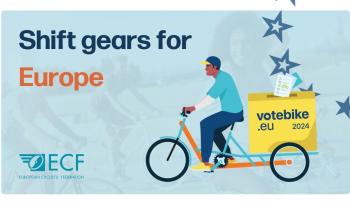
Impressions of COP21 – Bike Anjo
Mobility and cycling has never been so alive in the climate agenda. First of all, going to COP21 was not an easy task. At least 1 hour and three modes of transportation (subway, train and bus) to get to the venue. I would hear people talking about it everyday and seeing for themselves the necessity of tackling urban mobility issues and its relations to climate change.
Unfortunately, cycling was not promoted as a means to get to the COP21 venue. However, during a conversation with ECF’s Secretary General, Bernhard Ensink mentioned a very interesting initiative from UIC (International Union of Railways) who took delegates by Train to Paris and he himself did all the integration by bike sharing. This was an important symbol to show how bicycling can be part of the solution nationally or even regionally by integrating with trains.
Bikes were also present in the Green Zone, a sector with side events and exhibitions for all visitors apart from the negotiations, with different initiatives using cycling to generate power and music. There were also this type of equipments throughout the city of Paris. I was also happy to see that in the Green Zone there was one specific and big exhibition only to discuss and present solutions about cities.
The big discussions around cycling and urban mobility were led mainly through a coalition of the transport sector called the Paris Process on Mobility and Climate (PPMC) and gladly ECF and WCA were there to represent cycling. Within this union, the transport sector brought a series of Commitments to UN, among them three only in regards to cycling, in order to show their contributions and goals to tackle climate change within this sector.
Moreover, the PPMC, coordinated by the SLoCaT Partnership, promoted the Transport Day 2015 during COP21. The event brought a great emphasis on electric mobility, but fortunately there were many speeches which brought up another reality, especially on the developing countries, to think on basic accessibility to transportation, such as public transportation, cycling and walking, which are still decadent in many regions. Others also mentioned that a city with electric vehicles is still a city with traffic jams and impacts on its mobility and quality of life. Great remarks.
For many, COP21 ended with a promising agreement, assuming a possibility of reaching the target of increasing no more than 1,5ºC of the world’s temperature, but a lot still has to be discussed on how to reach this, which will take us to COP22 in Morocco. Promising to me was seeing the bicycle movements active and doing their part during the event, especially after reading the two documents I received from ECF/WCA and which shows some revolutionary information that has to be remembered in the next COP:
- The cycling deliveries for the Sustainable Development Goals, showing that cycling can contribute drastically to these global missions;
- The research “A Global High Shift Cycling Scenario”, which showed that, if we shift to bicycle friendly cities, we can reduce by 10% on greenhouse gas emissions in the transport sector and save US$25 trillion dollars by 2050.
Let us keep on riding our bikes and showing that this simple machine can take us to a more sustainable, low carbon world. And if you would like to know more about cycling in COP21, watch the video.
 About the Guest Author
About the Guest Author
JP Amaral is co-founder of the Bike Anjo Network in Brazil (bikeanjo.org) and a current German Chancellor Fellow from Alexander von Humboldt Foundation.
News category:
- Log in to post comments
Contact the author
Recent news!
Contact Us
Avenue des Arts, 7-8
Postal address: Rue de la Charité, 22
1210 Brussels, Belgium









